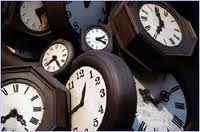‘Clocks slay time; only when the clock stops does time come to life.’ ~William Faulkner
Time. It’s all around us. We can’t escape it. We can’t ignore it. It constricts, dictates and ages us as humans, but time is just a concept.
This is at the root of our performance, as we develop our piece in a gallery which is surrounded by instruments of time. We are presenting a whole working day in 6 hours, and our development has led us into ideas of routine and the repetition which time brings. The routine of our daily lives; sleeping, waking up, eating, going to work, going out, all in a cycle which continues as the clocks progress into each hour.
What do you expect to see when you walk into any Gallery? Paintings, artefacts and displays. Certainly not a group of people asleep on the floor, or doing their daily routine! Our work is going to be pushing the boundaries of expectation and the abstract element of time.
Our chosen space is Gallery 3, within our given site of the Usher Gallery. We were drawn to this as artists because of the aesthetics of the room which contrast those of the spaces around the building. The building’s stunning architecture reflects that of a Manor House, both exterior and interior, with the winding staircase and stone floors. However, this totally changes when the public enter Gallery 3. Carpeted floors and walls and a dramatic change to a colour midnight blue, makes you question whether you have wandered into a completely different building. As we develop and explore our work, it is clear that subtle things become enlarged and exaggerated because of this confined environment.
This leads me onto discussing what the terms of ‘site’, ‘space’ and ‘place’ really mean- concepts which have been scrutinised by the many practitioners of site specific studies. Joanne Tompkins and Anna Birch, state ‘place’ under 3 critical concepts:
‘place as geographical site, place which situates social or historical position and the place or location of performance’.
(Joanne Tompkins, Anna Birch, Performing Site-Specific Theatre: Politics, Place, Practise. Palgrave Macmillan, 2012)
A space can be described in terms of being a ‘practised place’, as Jayne Rendell describes in her work Art and Architecture: A Place Between. Rendell uses the work of Michael Landy as an example of performance and its relationship between place and space. Landy performed a bold piece of performative work in 2001, with ‘Breakdown’, which took place in a vacant shop along Oxford Street in London, where he divested himself of all his possessions. A conveyor belt was installed on a circuit, overseen by men and women in blue overalls, including Landy himself. Over a durational period, every possession was circulated on this belt under categorized headings such as ‘clothing’ ‘electrical’ etc. This undoubtedly was a statement on capitalism due to the position of Oxford Street as being one of the busiest shopping locations in the country. But most importantly, Landy transformed a place using art intervention;
‘his work provided a ‘space’ of critical engagement in the ‘place’ of commodity consumption.’
(Jane Rendell, Art and Architecture: A Place Between, IB Tauris & Co, 2006)
With work such as this to inspire us, we too will be using art intervention to transform our place into a space; using Gallery 3 as a spatial practise to explore the concepts of time. Our work is also exploring the historical and cultural context of the artefacts that the room holds. The clocks are integral to the site as a whole, as they are to our piece. In its early origins, clock making was the most technically advanced job around, and during the 1800s and 1900s, was a means of flaunting wealth and status. Clockmakers would usually also be involved in making scientific instruments, due to their technical skills and knowledge. Focus, concentration and perseverance were needed in the art of clock making and these are traits which we will have to bring to our piece as performers, as our piece is durational and will be both mentally and physically exhausting.
The work we have been developing in workshops has led me to research further into other site specific performances by other companies. One that specifically interested me was a work entitled ‘Stop the Clocks’ by Tin Box theatre.
Tin Box theatre is a relatively newly established company, who performed a site specific work called ‘Stop the Clocks’ in 2011. Their piece took place in a disused coffin fitting factory in the centre of Birmingham, and presented the story of a fictional woman called Mary, at different stages of her life until her death. The work was inspired by the history of the factory and the testimonies of ex-employees. I think their chosen site is similar to the Collection and Usher Gallery due to its rich history.
Works Cited
Joanne Tompkins, Anna Birch, Performing Site-Specific Theatre: Politics, Place, Practise. Palgrave Macmillan, 2012
Jane Rendell, Art and Architecture: A Place Between, IB Tauris & Co, 2006


Yes thats what I thought too 🙂 definate parallels between our piece and theres!
Great find on the video Steph! I really liked when they described it as a ‘unusual theatre venue’, as our performance also falls into that category! The fact that their piece is so intimate may be of great influence to our piece, definitely worth some more research, their production looked incredible!